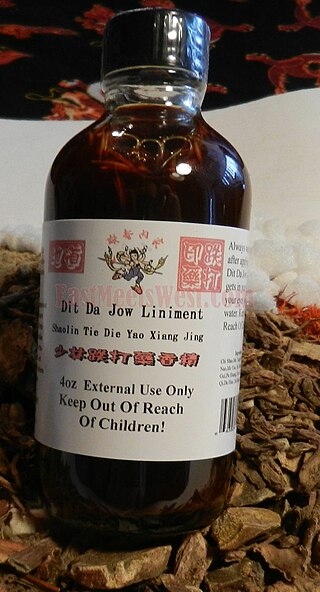
Liquorice or licorice is the common name of Glycyrrhiza glabra, a flowering plant of the bean family Fabaceae, from the root of which a sweet, aromatic flavouring is extracted.

Glycyrrhiza is a genus of about 20 accepted species in the legume family (Fabaceae), with a subcosmopolitan distribution in Asia, Australia, Europe, and the Americas.

Glycyrrhizol A is a prenylated pterocarpan and an isoflavonoid derivative. It is a compound isolated from the root of the Chinese licorice plant.

Glycyrrhiza uralensis, also known as Chinese liquorice, is a flowering plant native to Asia. It is used as a sweetener and in traditional Chinese medicine.

Dit da jow is a common Chinese liniment used as traditional medicine in the belief it can reduce the pain from external injuries.
Novosphingobium is a genus of Gram-negative bacteria that includes N. taihuense, which can degrade aromatic compounds such as phenol, aniline, nitrobenzene and phenanthrene. The species N. aromativorans, which was first found in Ulsan Bay, similarly degrades aromatic molecules of two to five rings.

Ononin is an isoflavone glycoside, the 7-O-β-D-glucopyranoside of formononetin, which in turn is the 4'-O-methoxy derivative of the parent isoflavone daidzein.
Glycyrrhiza inflata is a plant species in the genus Glycyrrhiza from China, with common name Chinese licorice. A related species, G. uralensis, however, is more likely the licorice species one finds in traditional Chinese medicine.

Liquiritigenin is a flavanone that was isolated from Glycyrrhiza uralensis, and is found in a variety of plants of the Glycyrrhiza genus, including Glycyrrhiza glabra (licorice). It is an estrogenic compound which acts as a selective agonist of the ERβ subtype of the estrogen receptor (ER), though it is also reported to act as an ERα partial agonist at sufficient concentrations. It also has a choleretic effect.

Liquiritin is the 4'-O-glucoside of the flavanone liquiritigenin. Liquiritin is one of flavone compounds derived from licorice.
Novosphingobium arabidopsis is a Gram-negative, rod-shaped and aerobic bacterium from the genus Novosphingobium which has been isolated from the rhizosphere of the plant Arabidopsis thaliana. Novosphingobium arabidopsis is resistant against dichlorodiphenyltrichloroethane (DDT).
Novosphingobium fluoreni is a Gram-negative, fluorene-degrading, rod-shaped and non-spore-forming bacterium from the genus Novosphingobium which has been isolated rice seeds from Jiansanjiang in China.
Novosphingobium marinum is a Gram-negative, aerobic and short rod-shaped bacterium from the genus Novosphingobium which has been isolated from sea water from the Pacific Ocean.
Brucella endophytica is a Gram-negative, aerobic, rod-shaped and bacteria from the genus of Brucella which has been isolated from the roots of the plant Glycyrrhiza uralensis from Yuli County in China.
Glutamicibacter endophyticus is a Gram-positive, aerobic and non-motile bacterium from the genus Glutamicibacter which has been isolated from the roots of the plant Salsola affinis in Urumqi, China.
Amnibacterium endophyticum is a Gram-positive, aerobic, non-spore-forming, short rod-shaped and non-motile bacterium from the genus of Amnibacterium which has been isolated from a branch of the tree Aegiceras corniculatum.
Frigoribacterium endophyticum is a Gram-positive and non-motile bacterium from the genus Frigoribacterium which has been isolated from the roots of the plant Anabasis elatior from Urumqi in China.
Okibacterium endophyticum is a Gram-positive and non-motile bacterium from the genus Okibacterium which has been isolated from the roots of the plant Salsola affinis from Xinjiang in China.
Pseudoclavibacter endophyticus is a Gram-positive, aerobic, rod-shaped and non-motile bacterium from the genus Pseudoclavibacter which has been isolated from the roots of the plant Glycyrrhiza uralensis from Yili County in China.
Brachybacterium endophyticum is a species of Gram positive, facultatively anaerobic, halotolerant, cream-pigmented bacterium. The cells are coccoid during the stationary phase, and irregular rods during the exponential phase. It was first isolated from surface-sterilized bark of Scutellaria baicalensis from Guizhou, China. The species was first proposed in 2018, and the name refers to the fact that the bacteria is likely an endophyte.







